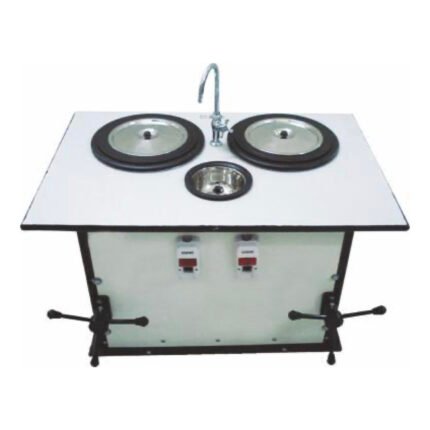AZA 1012 BRINELL HARDNESS TESTER
- AZA 1012 Brinell Hardness Tester: For accurate Brinell hardness measurement.
- Robust design for reliable testing.
- Wide force range and standard indenters.
- Available with optical or digital indentation measurement.
- Complies with IS 1500, ASTM E10, and ISO 6506-1.
- Essential for quality control of metallic materials.
- Suitable for testing non-homogeneous materials and large components.
Description
AZA 1012 Brinell Hardness Tester: Reliable Hardness Measurement for Quality Control by Azalab
The Azalab AZA 1012 Brinell Hardness Tester is a robust and reliable instrument designed for the accurate determination of the Brinell hardness of a wide range of metallic materials. The Brinell hardness test is a widely used indentation hardness test, particularly suitable for testing non-homogeneous materials or those with a coarse grain structure, providing a measure of the material’s resistance to permanent indentation. This test is crucial for quality control, material selection, and process optimization in various industries across India, including steel production, automotive, aerospace, and general manufacturing. The AZA 1012 offers a dependable solution for assessing the hardness of castings, forgings, and other large components.
Understanding Brinell Hardness Testing with the AZA 1012 Brinell Hardness Tester
The Brinell hardness test involves indenting the surface of a test piece with a hardened steel or tungsten carbide ball of a specified diameter (D) under a known force (F). The force is applied for a specific dwell time (typically 10-15 seconds). The diameter (d) of the resulting indentation is then measured, typically using a microscope or a digital measuring system. The Brinell Hardness Number (HBW) is calculated using the following formula:
HBW = 2F / (πD(D – √(D² – d²)))
The AZA 1012 Brinell Hardness Tester provides a controlled and consistent method for applying the force and measuring the indentation, ensuring accurate and reproducible results. The Brinell test is particularly useful for:
- Testing Non-Homogeneous Materials: Due to the relatively large indentation, the Brinell test averages out local variations in hardness, providing a more representative bulk hardness value.
- Testing Large Components: The method is well-suited for testing large castings, forgings, and heat-treated parts where a small indentation would not be representative.
- Quality Control: Verifying that materials meet hardness specifications for their intended application.
Key Features of the AZA 1012 Brinell Hardness Tester for Accurate Measurement: The Azalab AZA 1012 Brinell Hardness Tester is engineered for durability, ease of use, and precise hardness determination:
- Robust Load Application System: Features a reliable mechanical or hydraulic system for applying the test force, ensuring consistent and controlled force application.
- Wide Force Range: Offers a range of selectable test forces (e.g., from 500 kgf to 3000 kgf) to accommodate various materials and specimen thicknesses.
- Standard Indenters: Typically equipped with standard hardened steel ball indenters of various diameters (e.g., 2.5 mm, 5 mm, 10 mm). Tungsten carbide ball indenters may be used for testing harder materials.
- Clear Indentation Measurement: Depending on the model, the indentation diameter can be measured using:
- Optical System: A built-in microscope with a calibrated scale for direct measurement of the indentation diameter.
- Digital Measurement System: An optional digital system with a camera and image analysis software for automated and highly accurate indentation diameter measurement.
- Digital Display (Optional): Some models feature a digital display for direct readout of the Brinell Hardness Number (HBW), calculated automatically from the applied force and measured indentation diameter.
- Test Area Illumination: Provides adequate lighting for clear observation and measurement of the indentation.
- Safety Features: Includes safety mechanisms to prevent accidental overload and ensure operator safety.
- Easy Operation: Designed for straightforward operation, making it suitable for both experienced technicians and educational purposes.
Applications and Standards Compliance in the Indian Context: The Azalab AZA 1012 Brinell Hardness Tester is widely used across various industries in India and globally:
- Steel Industry: Testing the hardness of raw materials, semi-finished products, and finished components.
- Automotive Industry: Quality control of engine parts, gears, and other critical components.
- Aerospace Industry: Testing the hardness of aircraft components and materials.
- Foundries and Forging Plants: Assessing the hardness of castings and forgings.
- Heat Treatment Facilities: Verifying the effectiveness of heat treatment processes.
- Research and Development: Material characterization and development of new alloys.
The AZA 1012 is designed to perform tests in accordance with leading national and international standards, ensuring the reliability and comparability of results:
- IS 1500:2019: Indian Standard Method for Brinell Hardness Test for Metallic Materials.
- ASTM E10 – 18: Standard Test Method for Brinell Hardness of Metallic Materials.
- ISO 6506-1:2014: Metallic materials – Brinell hardness test – Part 1: Test method.
Azalab’s Commitment to Quality and Support: Azalab is dedicated to providing high-quality, precise laboratory and industrial equipment that supports critical material characterization and quality control. The AZA 1012 Brinell Hardness Tester reflects our commitment to innovation, accuracy, and user satisfaction. We understand the importance of reliable hardness data in ensuring product performance and safety. Our instruments are engineered to meet the stringent demands of modern testing laboratories in India and globally, backed by comprehensive customer support and service.
Further Information and Resources: For detailed operational procedures, specific specimen preparation guidelines, and information on selecting appropriate test parameters (force, indenter diameter), users should refer to the product manual, relevant industry standards, and consult with Azalab’s technical support team.
Specifications:
- Model: AZA 1012
- Tester Type: Brinell Hardness Tester
- Loading System: Mechanical or Hydraulic
- Force Range: Typically 500 kgf to 3000 kgf (selectable).
- Indenter Diameters: Standard hardened steel balls: 2.5 mm, 5 mm, 10 mm.
- Dwell Time: Typically 10-15 seconds (adjustable).
- Indentation Measurement:
- Optical System: Built-in microscope with calibrated scale.
- Optional: Digital measurement system with camera and software.
- Display:
- Analog Model: Direct reading of applied force.
- Digital Model (Optional): Direct readout of HBW.
- Maximum Specimen Height: [Specify typical range, e.g., 200 mm – 300 mm].
- Throat Depth (Distance from Indenter Axis to Machine Body): [Specify typical range, e.g., 130 mm – 150 mm].
- Power Supply: 230V AC, 50/60 Hz, Single Phase (for models with digital display or hydraulic system).
- Dimensions (Approx.): [H x W x D, e.g., 800 x 300 x 600 mm].
- Weight (Approx.): [e.g., 200-300 kg].
- Standards Compliance: IS 1500, ASTM E10, ISO 6506-1.
- Country of Origin: Made in India.
FREQUENTLY ASKED QUESTIONS (FAQ):
- Q: What does the AZA 1012 Brinell Hardness Tester measure?
- A: It measures the Brinell hardness (HBW) of metallic materials, which indicates their resistance to indentation.
- Q: What types of materials can be tested with this machine?
- A: It is suitable for testing a wide range of metals and alloys, including steel, cast iron, aluminum, and copper.
- Q: What are the typical force ranges and indenter diameters used in Brinell testing?
- A: Typical forces range from 500 kgf to 3000 kgf, and standard indenter diameters are 2.5 mm, 5 mm, and 10 mm.
- Q: How is the Brinell hardness number (HBW) calculated?
- A: HBW is calculated using a formula that considers the applied force, the indenter diameter, and the measured diameter of the resulting indentation.
- Q: Does the AZA 1012 have a digital display?
- A: Some models offer a digital display for direct readout of the HBW, while others use an optical system for indentation measurement.
- Q: What standards does the AZA 1012 comply with?
- A: It complies with major standards like IS 1500, ASTM E10, and ISO 6506-1.
Additional information
| Model |
AZA 1012 |
|---|---|
| Tester Type |
Brinell Hardness Tester |
| Loading System |
Mechanical or Hydraulic |
| Dimensions (Approx.) |
[H x W x D, e.g., 800 x 300 x 600 mm]. |
| Weight (Approx.) |
[e.g., 200-300 kg]. |
| Standards Compliance |
IS 1500, ASTM E10, ISO 6506-1. |
| Country of Origin |
Made in India. |
Related products
AZA 1010 TORSION TESTING MACHINE
- AZA 1010 Torsion Testing Machine: Measures material response to twisting forces (torque).
- Determines torsional strength, shear modulus, and ductility in torsion.
- Features high-precision torque transducer and angle encoder.
- Digital display for real-time torque and angle of twist readings.
- Complies with ASTM E143, ASTM A938, ISO 7881 standards.
- Essential for testing shafts, wires, fasteners, and other components under shear.
- Robust construction with versatile gripping system.
- Available in various torque capacities and test modes.
AZA 1011 ROCKWELL HARDNESS TESTER
AZA 1013 CHARPY IMPACT TESTER
- AZA 1013 Charpy Impact Tester: Measures material toughness and resistance to brittle fracture.
- Pendulum-type tester with robust construction for stability.
- Available with high-resolution analog or digital energy display.
- Complies with key Indian (IS 1757) and International (ASTM E23, ISO 148-1) standards.
- Essential for quality control of metals, alloys, and critical components.
- Features precise hammer, anvils, and safety braking system.
- Helps assess ductile-to-brittle transition temperature.
AZA 1014 FATIGUE TESTING MACHINE
- AZA 1014 Fatigue Testing Machine: Evaluates material resistance to cyclic loading.
- Predicts component service life and prevents fatigue failures.
- Features precise cyclic load application and high-frequency operation.
- Advanced digital control and comprehensive data analysis software.
- Complies with international standards like ASTM E466 and ISO 1143.
- Essential for R&D, quality control, and failure analysis in various industries.
- Robust construction ensures reliable and repeatable fatigue test results.
- Available with various load capacities and test modes (axial, bending, torsion).
AZA 1015 TENSILE TESTING MACHINE
- AZA 1015 Tensile Testing Machine: Advanced UTM for material characterization.
- Precisely measures tensile strength, yield strength, and elongation.
- Features high-precision load cell and digital control.
- Variable crosshead speeds for diverse material testing.
- Complies with major standards: IS 1608, ASTM E8, ISO 6892, etc.
- Includes user-friendly software for data analysis and reporting.
- Essential for quality control, R&D, and failure analysis across industries.
- Robust construction ensures reliable and repeatable results.
AZA 1016 METALLURGICAL INVERTED MICROSCOPE
- AZA 1016 Metallurgical Inverted Microscope: For precise inspection of opaque materials.
- Inverted design ideal for large, heavy, or irregular samples.
- High-quality infinity-corrected LWD metallurgical objectives (20x-1000x).
- Powerful Epi-Illumination (Halogen/LED) with Koehler setup.
- Robust mechanical stage and precise coaxial focusing.
- Trinocular head for camera attachment, enabling image capture.
- Essential for metallography, quality control, and R&D in materials science.
- Manufactured with durable die-cast aluminum stand
AZA 1017 DOUBLE DISC POLISHING MACHINE
- AZA 1017 Double Disc Polishing Machine: For superior metallurgical specimen finishing.
- Features two independent polishing discs for efficiency.
- Individual variable speed control for optimal results.
- Robust, corrosion-resistant construction with integrated water cooling.
- Achieves mirror-like, scratch-free surfaces for microstructural analysis.
- Essential for quality control, R&D, and failure analysis in materials industries.
- Enhances efficiency and reproducibility in sample preparation.
AZA 1018 SPECIMEN MOUNTING PRESS
- AZA 1018 Specimen Mounting Press: Essential for metallographic sample preparation.
- Robust manual hydraulic press for hot mounting.
- Features integrated electrical heating (up to 200°C) and water cooling.
- Digital temperature control for precise curing.
- Compatible with various interchangeable mold sizes (e.g., 25mm, 30mm, 40mm).
- Ensures consistent, void-free, and perfectly shaped mounts.
- Crucial for quality control, failure analysis, and research in materials science.

 Rock
Rock Aggregate
Aggregate Cement
Cement Concrete
Concrete Soil
Soil Steel
Steel Bitumen/Asphalt
Bitumen/Asphalt Security Survey Equipment
Security Survey Equipment General Items
General Items









